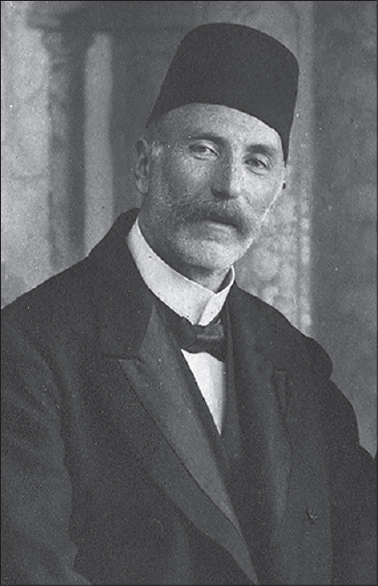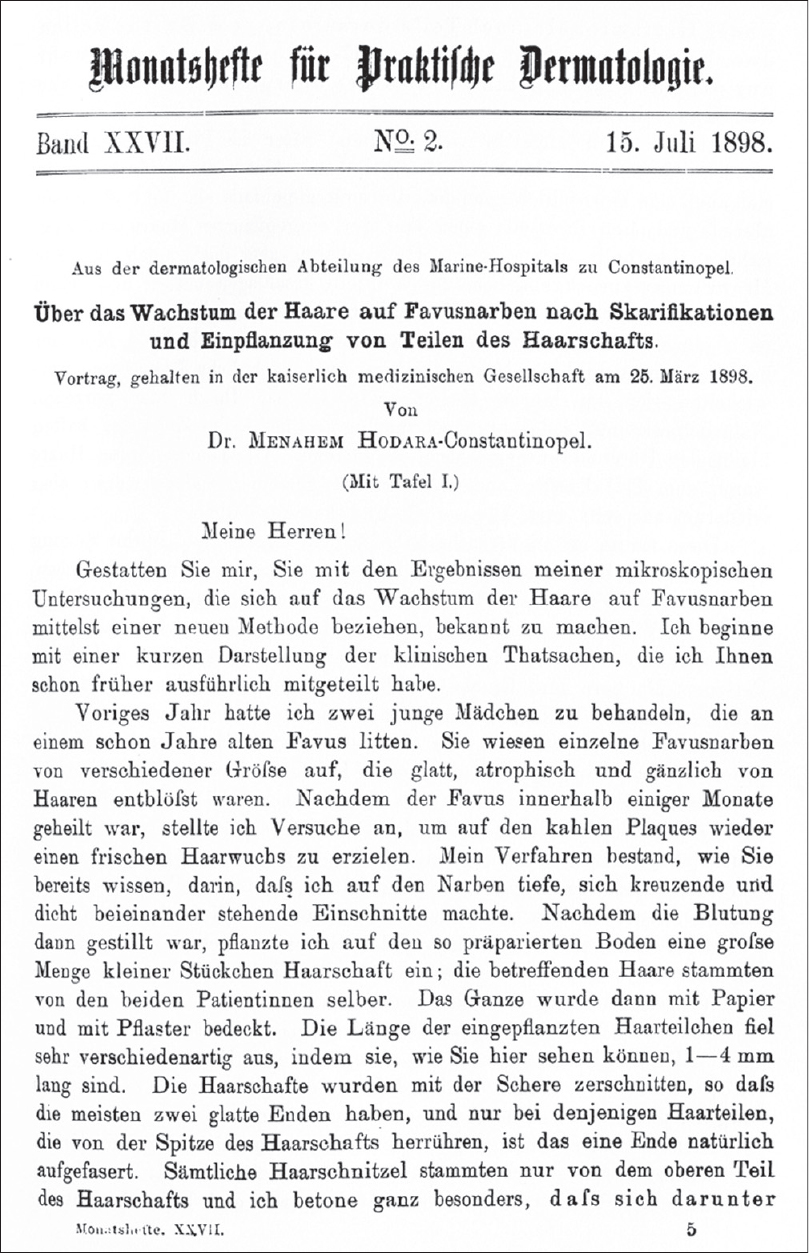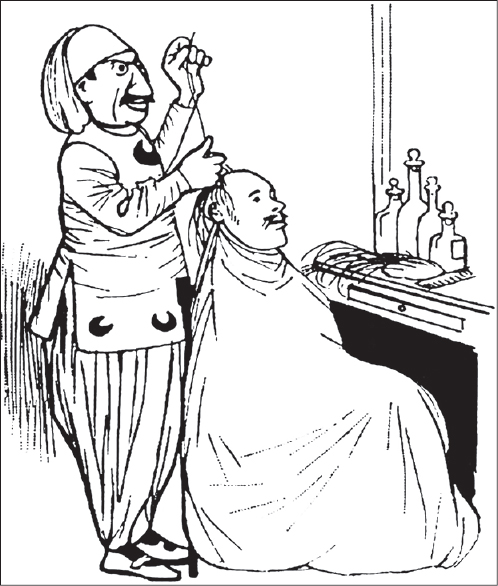Translate this page into:
The forgotten hair transplantation experiment (1897) of Dr. Menahem Hodara (1869 − 1926)
2 Department of Community Medicine and Health, The University Institute of the History of Medicine and Public Health, University of Lausanne, Lausanne, Switzerland
Correspondence Address:
Halil Tekiner
Department of Medical History and Ethics, The Gevher Nesibe Institute of the History of Medicine, Erciyes University, 38039 Kayseri
Turkey
| How to cite this article: Tekiner H, Karamanou M. The forgotten hair transplantation experiment (1897) of Dr. Menahem Hodara (1869 − 1926). Indian J Dermatol Venereol Leprol 2016;82:352-355 |
Introduction
Menahem Hodara (1869 − 1926) was an Ottoman dermatologist, acclaimed internationally for a number of contributions to the specialty in a career spanning 36 years. Some of his notable acheivements include identifying the bacilli responsible for the formation of comedones in acne and describing a type of trichorrhexis nodosa for the first time, which later came to be known as Hodara's disease. He also developed a novel form of glycerine jelly that melted at a lower temperature which helped to make its use less painful in patients with dermatoses.[1] However, none of his contributions to dermatology became as popular in his time as his hair transplantation experiment in 1897 which fell into oblivion after his death. Considering the long-neglected gap in medical history, this paper aims to present a detailed account of Hodara's experiment and its early reception in the field of dermatology.
Menahem Hodara and His Hair Transplantation Experiment of 1897
Menahem Hodara was born in 1869 in Istanbul, Turkey, to a modest Ottoman-Sephardic family. Following his graduation from the Imperial Military Medical School in 1890 as a lieutenant, Hodara was appointed in the Central Marine Hospital in Istanbul. Between 1893 and 1896, he studied at the Unna Clinic in Hamburgand became the first Ottoman dermatologist to specialize in dermatopathology. After his return to Istanbul in 1896, Hodara resumed his work at the Central Marine Hospital. He was appointed as a physician to the court pharmacy in 1905. Following his retirement from state employment in 1908, he launched his private practice in the district of Péra (modern day Beyoglu) in Istanbul [Figure - 1]. In 1919, Hodara et al. established the Society for Dermatology and Venereology of Turkey and he was elected its first president. His health gradually deteriorated in the 1920s and he finally passed away on July 9, 1926.[1]
 |
| Figure 1: Dr. Menahem Hodara in the early 1910s (Courtesy of the Hodara Family) |
During his tenure as a dermatologist at the Central Marine Hospital, Hodara conducted a hair transplantation experiment in 1897. Favus is a fungal infection of the scalp that was once quite common in the Middle East and Africa, leading to scarring alopecia. Hodara implanted hair taken from the unaffected areas of the scalp on to the scars that were left bald by favus. He first presented his findings in a session of the Imperial Society of Medicine in Istanbul held on March 26, 1897. He shared his subsequent findings in two other sessions on October 22, 1897 and March 25, 1898. Later, this communication was also published in German and French [Figure - 2].[2],[3]
 |
| Figure 2: Hodara's article on his hair transplantation experiment was published in Monthly Journal of Practical Dermatology in 1898 (Courtesy of the Countway Library of Medicine, Boston) |
According to the article which was titled “On the growth of hair in favus scars after scarification and implanting of portions of the hair,” Hodara cut hair from the head of young patients and trimmed these hair with scissors on both ends into lengths rangingfrom 1 to 4 mm. He also made several shallow incisions on the scars that were close together and crossing each other. After clearing the area properly until bleeding completely ceased, he steeply planted the hair fragments into the incisions. The areas were covered with a paper and then a sort of plaster. After 4 weeks, he removed the dressing and observed that although most of the implanted hairs came away with it, enough still remained to form the basis of a growth adequate to cover a large patch. After 3–4 months, some of the remaining hair became pigmented and robust, while the rest were rather thin and colorless.[2]
Later, Hodara performed microscopic examinations of these implanted hairs and noticed that they were normal in shape with new bulbs formed at the base of each. He repeated this experiment several times with other patients, each time observing that a few hair took root and grew. He finally concluded that his technique might be considered a promising commencement, despite being at a very early stage, he admitted, of a future hair transplantation practice but that it should be improved with new methods and instruments, allowing more regular and deeper incisions on the scars.[3]
Reception of Hodara's Experiment
Soon after its publication, Hodara's experiment received massive attention from the international press media [Figure - 3].[4],[5],[6],[7],[8] Being conscious of the topic's great popularity, some of these reports even bore very assertive titles, such as “Baldness conquered at last” and “No more bald heads.”[9],[10] Interestingly enough, Hodara's experiment received very little attention in the dermatology literature and was not discussed in detail for a long time, with a few exceptions.[11],[12] In 1906, Kapp wrote that he saw no positive success with the method described by Hodara.[13] At the 11th Congress of the German Society of Dermatology that was held in March 1914 in Vienna, Havas criticized Hodara's method of hair implantation, claiming that Hodara's method was inaccurate and that the hair taking root was merely a fantasy. Havas also repeated his opposition to Hodara's experiment in his article published in Archiv für Dermatologie und Syphilisin the same year.[14]
 |
| Figure 3: An imaginative cartoon of Dr. Hodara as a hairdresser was published in Musée des Familles in 1899 (Courtesy of the Bibliothèque Nationale de France, Paris) |
Hodara answered this critique in a letter published in Dermatologische Wochenschrift. He insisted on the accuracy of his results stating that he had satisfying histological results and that he believed his findings would be confirmed by another researcher in the future.[15] At the end of Hodara's letter, Unna, the editor of the journal, also commented on this issue by stating that 16 years earlier he had also tested the excision material of Hodara and found his data to be absolutely correct. Unna also pointed out that Hodara's positive results should stimulate research on implanting hair, on the broad base of animal experiments.[16] Inthe same year, Krusius referred to Hodara's study in his article about the implantation of live hair to create eyelashes.[17]
Subsequent Developments in Hair Transplantation Surgery
During the decades following Hodara's experiment, several distinguished dermatologists, including Schweninger, Kromayer, Székely, and Kapp, published articles on scalp hair grafting, demonstrating that success occurred only when a restricted number of hair in a small area was considered.[18]
The 1930s marked the true beginning of hair replacement surgery with great achievements accomplished mainly by the Japanese School of Dermatology: Sasagawa proposed a novel method for insertion of hair roots (1930), Passot succeeded in moving hair from a viable hair-bearing part of the scalp to a bald area (1931) and Okuda used cylindrical punches of hair from a donor site (1939).[19],[20],[21] Moreover, Fujita succeeded in grafting scalp fragments on the eyelid regions of lepers in 1953.[19]
The hair transplantation technique of modern days, however, was developed in the early 1950s by Orentreich. He developed the concept of “donor dominance” to explain the ability of the transplanted hair to retain the same characteristics of the hair from where it was taken.[22],[23] Punch grafts or “plugs,” were introduced in the 1970s with unsatisfactory cosmetic results. At the International Congress of Plastic Surgeons in 1975, Juri presented a flap procedure that bears his name. In Juri's procedure, two long flaps of hair-bearing scalp were used to cover bald regions.[24],[25] The following decades have also seen considerable progress in hair transplantation and some new techniques have been developed, such as the “follicular unit transplanting” that was introduced in the 1990s by Limmer. This technique still remains popular as a truly natural look has been made possible, thanks to individually transplanted hair follicles.[22],[23]
Conclusion
Dr. Menahem Hodara's experiment of 1897 might be considered as one of the initial premises for hair transplantation – at least in a theoretical sense – which places him among the pioneers of hair transplantation and one of the outstanding figures in the history of dermatology.
Acknowledgment
The authors thank Messrs Mario and Sami Hodara, grandsons of the late Dr. Menahem Hodara, for their courtesy in granting access to the Hodara family archive.
| 1. |
Tekiner H. Dr. Menahem Hodara (1869-1926) and his contributions to dermatology. Int J Dermatol 2016;55:114-6.
[Google Scholar]
|
| 2. |
Hodara M. [On the growth of hair in favus scars after scarification and implanting of portions of the hair]. Monatsh Prakt Dermatol 1898;27:53-64.
[Google Scholar]
|
| 3. |
Hodara M. [The growth of hair in favus scars after scarifications and implanting of portions of the hair]. Paris: Imprimerie Daix Frères; 1899.
[Google Scholar]
|
| 4. |
Anonymous. [The cultivation of hair]. La Croix Supplément; 30 January, 1899. p. 1.
[Google Scholar]
|
| 5. |
D'Araujo O. [Hair planting]. Sci Française 1899;9:14-5.
[Google Scholar]
|
| 6. |
Anonymous. [A work of patience against baldness]. J Chartres; 27 January, 1899. p. 8.
[Google Scholar]
|
| 7. |
Anonymous. Hair planting. The Newcastle Courant; 21 October, 1899. p. 2.
[Google Scholar]
|
| 8. |
Anonymous. Bald spots ploughed and sown. The Evening Post; 4 May, 1900. p. 6.
[Google Scholar]
|
| 9. |
Anonymous. Baldness conquered at last. Science Siftings; 11 March, 1899. p. 1.
[Google Scholar]
|
| 10. |
Anonymous. No more bald heads. The Washington Bee; 8 July, 1899. p. 2.
[Google Scholar]
|
| 11. |
Anonymous. The operative treatment of baldness. BMJ 1899;1:492-3.
[Google Scholar]
|
| 12. |
Chatelain E, Méheux F. [Precise Iconographic Skin Diseases]. Paris: A. Maloine; 1905.
[Google Scholar]
|
| 13. |
Kapp J. [A new method of hair transplantation]. Monatsh Prakt Dermatol 1906;43:169-71.
[Google Scholar]
|
| 14. |
Havas A. [On hair transplantation]. Arch Derm Syph 1914;119:154-7.
[Google Scholar]
|
| 15. |
Hodara M. [On Havas's critism of my study: On the growth of hair in favus scars after scarification and implanting of portions of the hair]. Dermatol Wochenschr 1914;59:84-6.
[Google Scholar]
|
| 16. |
Unna PG. [Editor's afterword]. Dermatol Wochenschr 1914;59:86.
[Google Scholar]
|
| 17. |
Krusius FF. [On the implantation of living hairs to form eyelashes]. Dtsch Med Wochenschr 1914;40:958.
[Google Scholar]
|
| 18. |
Segrave K. Baldness: A Social History. North Carolina: McFarland & Company; 1996.
[Google Scholar]
|
| 19. |
Bouhanna P, Dardour JC. Hair Replacement Surgery: Textbook and Atlas. New York: Springer; 1996.
[Google Scholar]
|
| 20. |
Stough DB, Haber RS. Hair Replacement: Surgical and Medical. St. Louis: Mosby-Year Book; 1996.
[Google Scholar]
|
| 21. |
Leavitt ML. Follicle facts. In: Haber RS, Stough DB, editors. Hair Transplantation. Philadelphia: Elsevier Saunders; 2006. p. 187-90.
[Google Scholar]
|
| 22. |
Kuntzman G. Hair: Mankind's Historic Quest to End Baldness. New York: Random House; 2001.
[Google Scholar]
|
| 23. |
Unger WP. The history of hair transplantation. Dermatol Surg 2000;26:181-9.
[Google Scholar]
|
| 24. |
Mayer TG, Fleming RW. Aesthetic and Reconstructive Surgery of the Scalp. St. Louis: Mosby-Year Book; 1992.
[Google Scholar]
|
| 25. |
Vallis CP. Hair Transplantation for the Treatment of Male Pattern Baldness. Illinois: Charles C. Thomas Publications; 1982.
[Google Scholar]
|
Fulltext Views
6,438
PDF downloads
2,172





